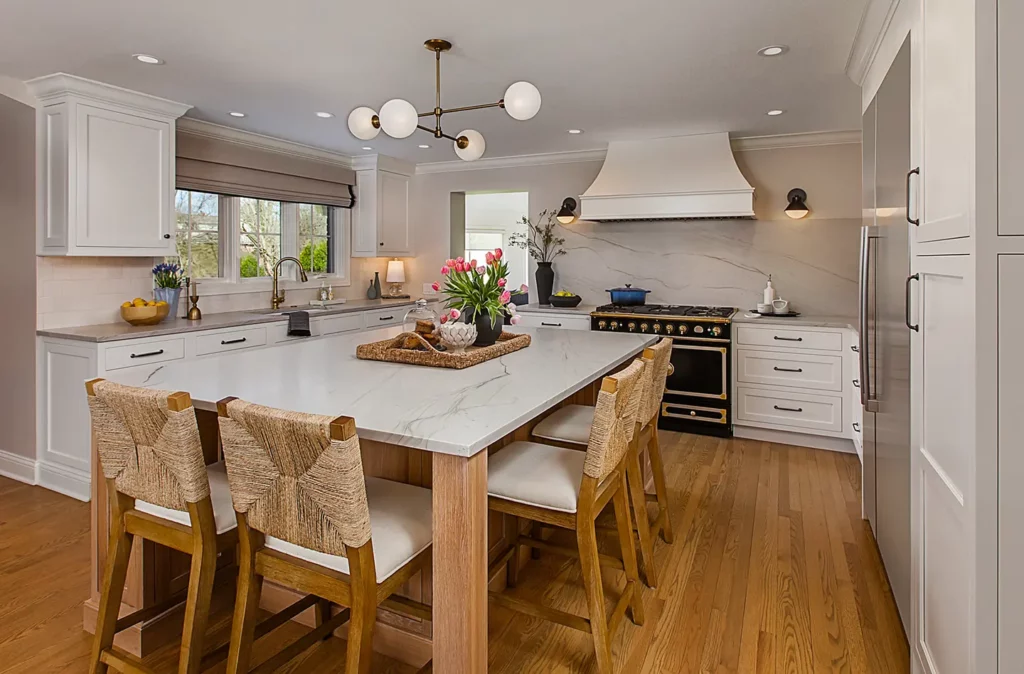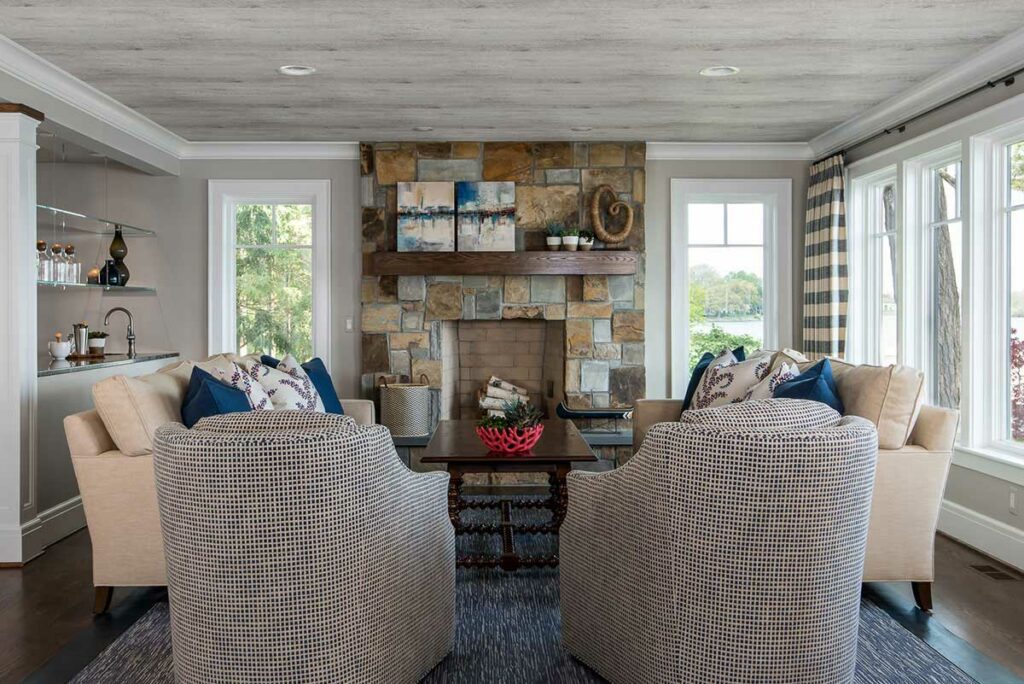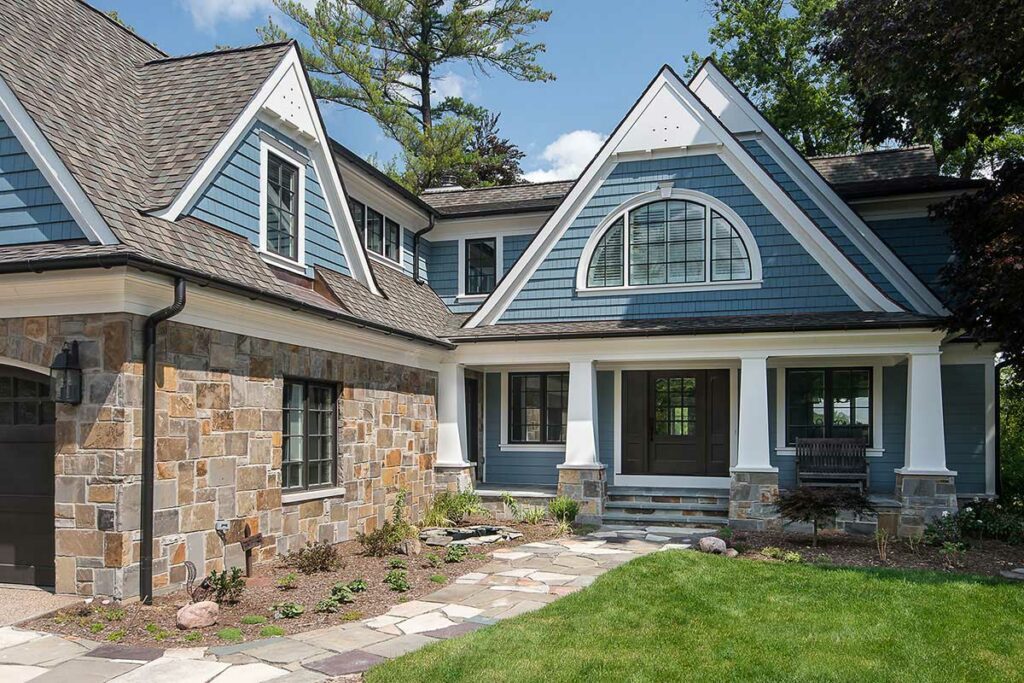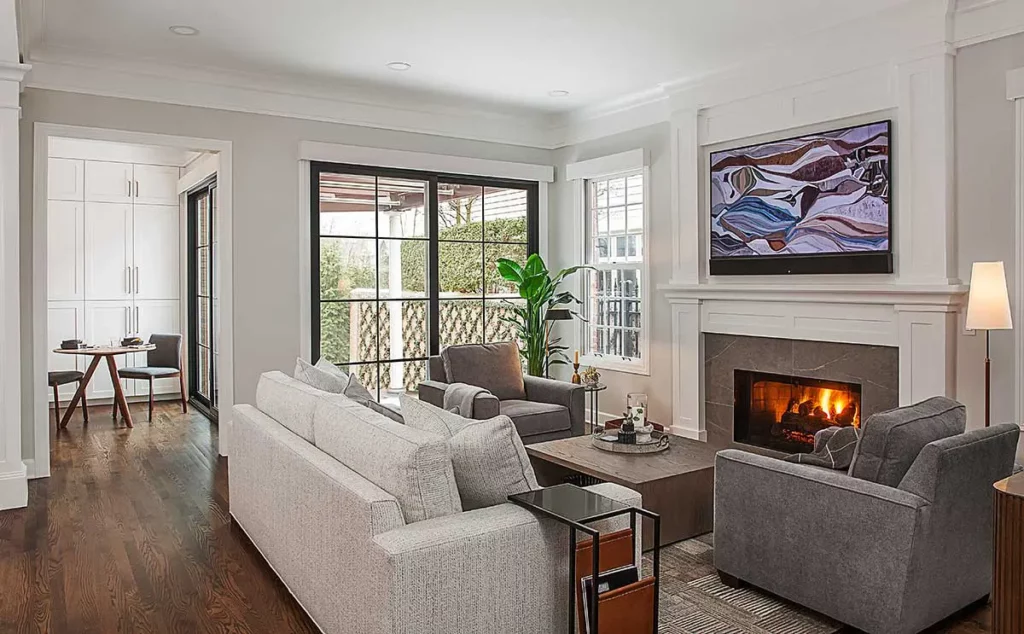When deciding whether to remodel your current home or move into a new one, you’re at an important crossroads—one that will shape your lifestyle for years to come. This decision goes beyond finances. It’s about aligning your living space with your evolving needs, family priorities, and long-term vision for the future.
Whole home remodeling allows you to transform your existing home into a more functional, beautiful, and personalized space—without the disruption of relocating. On the other hand, buying a new home can offer a fresh start, expanded amenities, or a new location that better supports your future vision.
To help guide this important decision, ask yourself these seven essential questions—each designed to help you weigh your options through the lens of investment, timing, emotional attachment, and the real costs of remodeling versus buying.
7 Questions to Consider: Whole-Home Remodel or Buy a New Home?
The seven questions below are designed to help you thoughtfully weigh every key factor in deciding whether to pursue a whole-home remodel or buy a new house. While the checklist offers a clear starting point, the rest of the article expands on each question—providing context, insight, and practical guidance to support the most informed decision for your home, budget, and lifestyle.
The column with the most checkmarks will point you toward the option that best aligns with your goals and priorities.
| Questions | Remodeling | Buying a New Home |
| Question #1: What Costs Can You Afford? | Remodeling Costs | Renovation Costs |
| Question #2: What Does Your Current Home Lack | Upgrades, Indoor Space | A Sound Structure, Foundation, or Systems, Outdoor Space |
| Question #3: What Are the Features and Amenities You Can’t Live Without | Prefer to Upgrade These Features and Amenities | Prefer to Replicate or Add Them as Upgraded Versions in the New House |
| Question #4: How Long Do You Plan to Stay in Your Existing Home? | A Decade or More | Less than a Decade |
| Question #5: Is Now the Right Time to Buy a Home in the Current Real Estate Market? | Yes | No |
| Question #6: How Emotionally Attached Are You to Your Home and Neighborhood? | A Lot, Uprooting My Life and My Family’s From Here Will be Overwhelming. | I Believe Our Lives Would Improve In Another Place |
| Question #7: Which Disruption Is Easier—Renovating Your Home or Moving to a New One? | We Can Live with the Construction or Temporarily Live Elsewhere for 6-12 Months. | Buying a Home, Packing and Moving, and Adjusting to a Whole New Life in Another Place is Better for Me and My Family. |

Q1: What Costs Can You Afford: Renovation Costs vs. Buying New Homes
When weighing the decision to remodel or buy a new home, it often comes down to one essential factor—cost. Making a rational, informed decision starts with understanding your financial limits and comparing the true cost of renovating versus buying and moving.
Costs of Renovation
When planning a whole home remodel, one of the most practical budgeting strategies is the 30% rule—a guideline suggesting that homeowners should invest no more than 30% of their home’s value in total renovation costs to avoid overcapitalizing. For instance, if your home is valued at $600,000, your ideal remodel budget should stay within $120,000.
Key remodeling costs typically include materials, labor, and professional design services, especially for high-impact areas such as kitchen remodeling or bathroom renovations. These spaces typically require specialized trades such as plumbing and electrical, custom cabinetry, and premium finishes—all of which can increase your project’s complexity and cost.
In addition to construction and design, your renovation budget should account for permits, inspection fees, and local regulations, which can depend on the scope of your remodeling project.
Fortunately, financing options such as home equity loans or home equity lines of credit (HELOCs) can help make your remodeling goals more attainable, leveraging the value of your existing home without requiring a full cash payment upfront.
Costs of Relocation
When deciding whether to buy a new home or remodel, it’s essential to factor in the full scope of relocation expenses, which often extend far beyond the purchase price of the house itself.
To start, sellers typically pay real estate commissions ranging from 5% to 6% of the current home’s sale price. Buyers then face closing costs—an additional 3% to 7% of the new home’s purchase price—covering everything from mortgage application fees and title searches to home inspections and appraisals. These transaction-related expenses can quickly add up to five figures in out-of-pocket costs.
Beyond the paperwork, the physical act of moving carries its own financial burden. Homeowners often incur costs for:
- Hiring professional movers
- Renting trucks or trailers
- Purchasing packing materials
- Temporary storage solutions
Even a local move under 100 miles can cost up to $2,000, while long-distance moves may exceed $5,000, depending on the volume of belongings and distance traveled.
And then there are the soft costs that often go overlooked—like taking time off work, managing school re-enrollment, or adjusting to a longer commute. These disruptions can add both emotional stress and financial strain to the overall moving process.

Q2: What Does Your Current Home Lack?
After evaluating the remodeling costs versus the cost of buying a new home, the next step is assessing whether your current house truly supports your lifestyle. Take a moment to evaluate your existing home with an honest lens—consider its layout, square footage, location, and how well it functions for your day-to-day living.
Is your home meeting your current and future needs? Perhaps your children have outgrown shared bedrooms, or you’re now working remotely and need a dedicated home office. These evolving needs can often be addressed through a thoughtful home remodeling project.
When Remodeling is the Answer
If your home’s structure and location still serve you well, then a remodel may be the smarter, more cost-effective option. Today’s residential remodeling services include everything from home additions and layout reconfigurations to modern design upgrades—all tailored to enhance your living space. With the right contractor, you can even integrate warranty-backed improvements to minimize long-term maintenance and repair costs.
When Buying a New Home is the Practical Choice
That said, there are situations where renovating may not be enough. If your home has significant structural issues, outdated systems, or a compromised foundation, the renovation costs may outweigh the return on investment. In those cases, choosing to buy a new home could offer a cleaner, more financially sound path forward.
Additionally, while home remodeling can significantly maximize indoor space, it can’t change the limitations of your lot size. If you live in a suburban neighborhood with minimal outdoor space, relocating to a more rural area may give you the land, privacy, and freedom you simply can’t achieve through renovation.

Q3: What Are the Features and Amenities You Can’t Live Without?
Once you’ve evaluated what you need in a home, the next step is to consider what already works—and whether you want to preserve or enhance those features. Take a close look at your existing home: do the features and amenities you enjoy today simply require upgrades, or would buying a new home be necessary to achieve your ideal living space?
Remodel to Upgrade or Buy a New Home and Replicate?
For example, perhaps your kitchen has smart storage cabinetry that makes meal prep effortless. Would it be easy—or even possible—to find a similar setup in a new home, or would you need to invest additional time and money to recreate it?
Or consider specialized modifications that support your lifestyle. If your current home features accessibility upgrades like wider hallways, a first-floor suite, or a walk-in shower for a wheelchair-bound loved one, these thoughtful features may not be standard in a newly purchased home. Replicating them elsewhere could require both design and construction work after you move.
A professionally planned home remodeling project can improve upon what you already love, adding custom enhancements that further support your day-to-day needs. In contrast, purchasing a new home may come with compromises—or delays—as you work to make it feel truly your own.

Q4: How Long Do You Plan to Stay in Your Existing Home?
Now that you’ve identified the essential features and amenities your home must have, it’s time to consider your long-term plans. Are you staying in your existing home for just a few years, or are you planning to settle in for the next decade or more?
If You Only Plan to Stay for a Few Years
If you anticipate moving within a few years, the remodeling cost may not deliver a worthwhile return on investment. Many home renovations take time to appreciate in value, both financially and through improved day-to-day livability. With short-term ownership, you may not live in the home long enough to recoup renovation costs or fully enjoy the benefits of upgraded features.
If You Plan to Stay for a Decade or More
If you plan to stay for the long term, a whole-home remodeling project can significantly enhance your quality of life. A well-planned remodel allows you to customize your living space to meet evolving lifestyle needs, improve functionality, and reflect your personal style. Over time, quality renovations can enhance home value, reduce ongoing repair costs, and support goals such as aging in place or multigenerational living.
Still uncertain about your timeline? A conversation with a trusted remodeling professional can help you determine whether a home remodeling project is the right long-term investment for your situation.

Q5: Is Now the Right Time to Buy a Home in the Current Real Estate Market?
As you weigh the decision between remodeling or buying a new home, understanding the current real estate market is crucial. Market conditions can influence not only the cost of buying a home but also the potential return on either investment. Let’s explore how timing impacts both paths.
When to Remodel
In today’s competitive housing market, home buyers are often pulled into bidding wars, especially in high-demand areas. This can lead to multiple failed offers, inflated home costs, and a stressful buying experience. If housing prices in your area have surged, remodeling your existing home may be the more cost-effective and emotionally manageable choice.
A home remodeling project allows for:
- Greater control over timeline and cost
- Customization based on your specific lifestyle needs
- Avoiding the uncertainty of market-driven price hikes
By staying put and upgrading your current space, you may be able to avoid market volatility while still achieving the home you want.
When to Buy
If you’re considering a move to a more expensive neighborhood or seeking new amenities your current property can’t offer, buying a new home may still be the right path. However, even when moving appears cheaper than renovating, that doesn’t always translate to a better return on investment.
Timing is critical when it comes to home buying:
- Spring and summer tend to be high seasons, with faster sales and higher asking prices.
- Research your local market conditions, including property trends, demand levels, and market average time.
- Compare the total cost of buying—including closing costs, moving expenses, and potential renovations in the new home—to a comparable remodeling plan for your existing home.
If the market is hot and inventory is low, renovating your home may deliver greater value and peace of mind.

Q6: How Emotionally Attached Are You to Your Home and Neighborhood?
Deciding between a whole-home remodeling project and buying a new house often extends beyond financial considerations—your emotional connection to your existing home plays a powerful role. Whether it’s where your child took their first steps or where you shared milestones with loved ones, your home holds irreplaceable memories.
At the same time, you may be dreaming of bluer skies and greener meadows, seeking a fresh start or lifestyle change that a new location could offer. The question becomes: Are your roots holding you close—or is it time to grow somewhere new?
Staying but Growing
Our emotional attachment to our homes often runs deeper than expected, making the thought of moving feel overwhelming. But the decision isn’t only about the house—it’s also about your ties to the neighborhood and community.
Familiarity with local parks, shops, schools, and routines provides a sense of stability and belonging that’s hard to recreate. If you’ve built strong relationships with neighbors or have children thriving in their school district, that emotional investment could outweigh the benefits of starting over.
In these cases, a home remodeling project may be the ideal solution. Renovating allows you to honor your home’s sentimental value while updating it to match your lifestyle needs. From kitchen renovations to home additions, remodeling gives you the best of both worlds—growth without relocation. It also reduces the stress of moving, especially when the idea of uprooting your life brings more emotional strain than satisfaction.
Moving for Better Things
Still, there are many valid reasons why buying a new home may be the right choice. You might need more square footage, want a more affordable mortgage, or prefer a shorter commute. Perhaps you’re looking for a better school district or need to be closer to your workplace or family.
When the practical benefits of a move outweigh your emotional ties, relocating can open the door to a better quality of life. If your existing home can’t be remodeled to meet your needs, and the cost of buying aligns with your budget and goals, then purchasing a new home may offer the fresh start you’re looking for.

Q7: Which Disruption Is Easier—Renovating Your Home or Moving to a New One?
Whether you choose to remodel or buy a new home, some degree of disruption is inevitable. The key question is: which type of disruption—construction or relocation—aligns better with your family’s lifestyle, stress tolerance, and financial flexibility?
Remodeling Means Living Through Construction—or Living Elsewhere Temporarily
Choosing to stay in your existing home for a whole-home remodeling project means maintaining your daily routine, staying in your current school district, and remaining close to familiar parks, shops, and community networks. For families with children or animals— or those who value stability—this consistency can be a major advantage.
However, remodeling also comes with its own challenges. Depending on the scope of your renovation, you may face 6 to 12 months of construction, dust, noise, and limited access to essential living spaces. In some cases, families may need to relocate temporarily, which can introduce additional costs such as rent, storage, and utility fees.
Still, many homeowners find that the temporary inconvenience of remodeling is worth it to avoid the stress and expense of a full move.
Moving Has Its Own Stressors
While moving into a new home may seem like the faster route to a finished space, it involves significant disruption as well. From house hunting, bidding wars, and mortgage applications to packing up your entire life, the process can take weeks—or even months.
Once the move is complete, there’s the adjustment phase: learning a new neighborhood, establishing new routines, and possibly dealing with the emotional toll of leaving behind a familiar environment.
Even if buying a new home feels more straightforward on the surface, it can be emotionally and logistically taxing, particularly if you’re not gaining a significant upgrade in home functionality, square footage, or lifestyle improvements.

Ready to Remodel? Let’s Talk About Your Home’s Potential
Choosing whether to remodel or buy a new home involves weighing numerous personal and financial factors, including cost, lifestyle needs, emotional attachment, and market timing. By asking yourself the seven essential questions outlined in our guide, you can confidently make informed decision that matches your values and long-term goals.
If your roots are connected to your existing home and you’re seeking to improve functionality without the hassle of moving, a whole home remodeling project is often the right choice. It allows you to customize your living space and maintain your routine while investing in the property that you already love.
With over 33 years of expertise in residential remodeling, MainStreet Design Build offers a full-service approach to whole-home renovations. Our in-house team provides personalized guidance for a seamless and stress-free remodeling experience.
Ready to explore the full potential of your home? Consult with us today and discover how our comprehensive home remodeling services can help you transform your existing space into your dream home, all without leaving your neighborhood.



